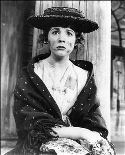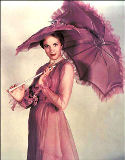Chapter 1
Relationships
1.3 Terminology
1.3.3 Words
Words! Words! Words! I'm so sick of words!
I get words all day through;
First from him now from you!
Is that all you blighters can do?
Eliza Doolittle in My Fair Lady

By now you may share some of Eliza's anger and frustration. The outburst was directed at her would-be suitor, Freddie, but she was really angry at her chief tormentor, Professor Henry Higgins (the “him” in the lines quoted above), who was trying to mold her in his image of an English gentlewoman by freeing her from the straitjacket of a Cockney dialect. We intend to achieve the unintended result of Professor Higgins' efforts: by freeing you from your linguistic straitjackets, to enable you to become independent thinkers.

Transformed Eliza
(Julie Andrews, 1956)
Lerner and Loew's musical My Fair Lady was based on Shaw's play Pygmalion, which in turn was based on a Greek myth whose central character was a sculptor who fell in love with one of his statues that was brought to life by Aphrodite (a.k.a. Venus), the goddess of love and beauty. The theme is a common one that you may encounter in many other courses. Indeed, you are part of an ancient tradition that runs through thousands of years of literature, art, and education.
Thus we consider it vitally important that you learn and use correctly the language of mathematics, that is, of quantitative reasoning. We have devoted these many pages of words — with very few mathematical symbols — to examination of the word “function” precisely because this word represents the concept that will be our principal object of study.
We have a small confession to make. When we quoted the Merriam-Webster Online Dictionary on the definition of “function,” we left out something: its mathematical definition. Here is the missing part of the quotation:
5a: a mathematical correspondence that assigns exactly one element of one set to each element of the same or another set b: a variable (as a quality, trait, or measurement) that depends on and varies with another <height is a function of age>
Perhaps you see why we left this out earlier. First, in stark contrast to the other four definitions, these two statements are rather difficult to read and interpret. Why would a lexicographer write four straightforward definitions for different meanings of a word and then apparently obfuscate the technical meaning? Second, this appears to be two quite different definitions for only one concept — or do mathematicians use the one word “function” for two rather different concepts?
The dictionary definition does not tell us that 5a. and 5b. actually define the same concept or that the concept is merely an abstraction of our alternate definition.
We trust that you have figured all this out from our examples, exercises, and other activities. We summarize our definitions here.
| Definitions A function is a pairing of the values of one varying quantity with the values of another varying quantity in such a way that each value of the first variable is paired with exactly one value of the second variable. The first variable is called independent, and the second variable is called dependent. The set of all values of the first variable is called the domain of the function. |
In Activity 1 of Section 1.1, you wrote your initial understanding of the word “function.” The time has come to review your description. Have we made a connection yet? If not, our failure to connect may result from your use of formulas to define, describe, or exemplify functions. You may have noticed that hardly any formulas have turned up yet. We will see lots of formulas later—when they serve some useful purpose—and you will have many opportunities to use all those wonderful things you have learned about algebra and trigonometry. For now, the point we want to make is this: “Function” and “formula” are not synonyms! And “equation” is not a synonym for either “function” or “formula.”
The word “expression” may not be part of the vocabulary you learned in previous mathematics courses, but its definition may be one that you routinely confuse with “function” or “formula” or “equation.” In fact, “formula” and “expression” are closely related — little harm results from using them interchangeably. “Equation” is a very special kind of formula or expression, one that asserts the equality of two quantities — each of which also may be described by a formula or expression.
None of this — equation, formula, expression — has any direct connection with function. However, the rule associating values of a dependent variable with values of an independent variable might be expressed by an equation or a formula or an expression. This almost never happens in the real world. However, as we have seen already, reality often can be modeled by formulas, and the functional rules embodied in those formulas may turn out to be convenient and/or useful approximations to reality.
Thus we will move freely among
-
the real — but not completely knowable — functions that relate varying quantities in physics, biology, chemistry, engineering, or economics,
-
the observed functions represented by data sampled from measurements of the real variables, and
-
mathematical model functions that approximate one or both of the other types.
Only in this last category will we see any formulas. Indeed, this is the purpose of formulas: to give us approximate models of reality that are subject to manipulations that can, in turn, help us to understand reality.
Historical Background: Function and Related Concepts
Image credits



